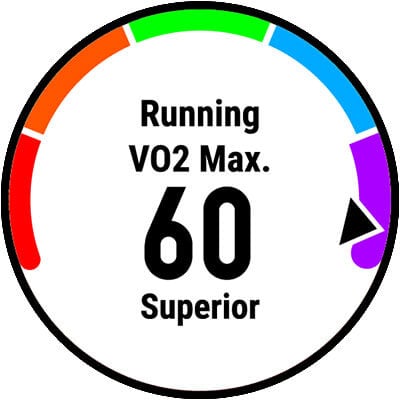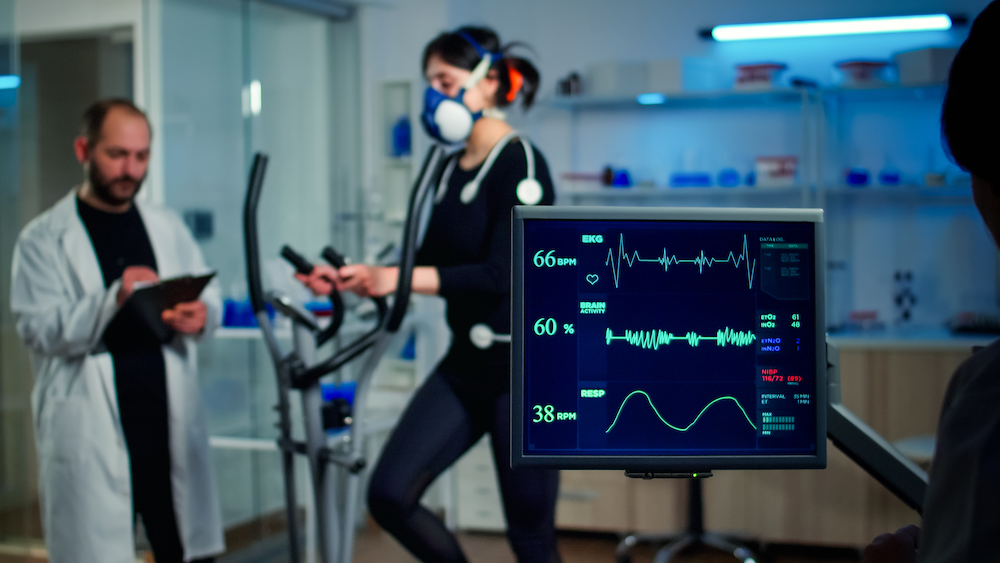In the world of fitness, the VO2 max is considered the gold standard for assessing the endurance or aerobic fitness of an individual, and it’s likely that you’ve heard the term mentioned in conversation with running friends once or twice.
But you might be wondering what it is exactly, and whether or not it’s really as important as people would have you believe.
Interestingly, you have likely been improving your VO2 max and running economy for quite some time – assuming you run regularly – without you even knowing it.
In this article, we’re going to break down VO2 max in the context of running and explain what exactly it is and how it can help you as a runner improve your performance. If you’re looking to learn more about it, then you’ve come to the right place.
Read on for a full explanation of this popular metric and to find out how it impacts your heart, your health, and your workouts.
What Exactly Is VO2 Max?
In Layman’s terms, your VO2 max is the total volume of oxygen that your body is able to use when you are performing dynamic exercise – that is, when you’re running or working out in a gym. It is often also called maximum aerobic power and is a measurement of how well your body is able to circulate and utilize oxygen while you are performing aerobic exercise.

Your VO2 max reflects how much blood you have, how strong your heart is, the number of red blood cells that are present in your bloodstream, and how well your blood flows to your body’s working muscles. It also measures the volume of oxygen that is consumed by your mitochondria, which are the powerhouses of the cells.
Is VO2 Max Really That Important to Your Health?
The short answer: yes. VO2 max definitely has a big role to play in your performance when running for any endurance event because it is a representation of the maximum work rate that you are able to perform. VO2 max is directly related to how quickly you will run at the end of the ramp test, as well as how fast you will be able to run any kind of race, be it a 5km, 10km, marathon, or half-marathon.
With that being said, VO2 max certainly is not the be-all end-all, and it is possible for someone to have a VO2 max that is genetically very high but be quite untrained and have a bad running economy. Having a good VO2 max also isn’t going to make you immune to getting injured – another important puzzle piece is how near you are able to get to your VO2 max while staying below your anaerobic threshold.
This threshold is a representation of the highest intensity of exercise you are able to sustain for prolonged periods without lactic acid accumulating in your blood. Being able to work at a significantly high VO2 percentage is, ultimately, what separates good athletes from the cream of the crop, rather VO2 max itself.
Let’s take a look at an example:
There are two athletes, we’ll call them ‘A’ and ‘B’, and both of these athletes have an identical running economy. The VO2 max of Athlete A is 60ml/kg/min, while the VO2 max of Athlete B is 65ml/kg/min.
In a race of 5km, Athlete A will be able to run at 95% of their VO2 max for the entirety of the race, which means that their body is consuming 57ml/kg/min of oxygen during the race. On the other hand, Athlete B is only able to run at 85% of their VO2 max for the same 5km race, which means that they are using 55ml/kg/min for the race.
This means that Athlete B is not able to maintain the same running velocity as Athlete A, even though Athlete B has a greater VO2 max. Here’s an example of the normal VO2 max values for runners:
| AGE | MEN | WOMEN |
| 20-29 | 47-55 ml/kg/min | 30-46 ml/kg/min |
| 30-39 | 43-52 ml/kg/min | 33-42 ml/kg/min |
| 40-49 | 38-42 ml/kg/min | 30-38 ml/kg/min |
| 50-59 | 36-44 ml/kg/min | 26-35 ml/kg/min |
| 60-69 | 31-38 ml/kg/min | 24-33 ml/kg/min |
| 70-79 | 28-35 ml/kg/min | 20-27 ml/kg/min |
How VO2 is Measured
If you want to measure VO2 accurately, you will have to visit an exercise physiology lab that is equipped with a device called a metabolic cart. GPS watches can give you VO2 max estimates, but to get a proper VO2 max reading, you will need to do the lab treadmill test, as this is the most accurate way to properly assess your personal data.
Metabolic carts measure the amount of oxygen that is used by your body, as well as the amount of CO2 – carbon dioxide – that your body creates when you exercise.
This is measured via the concentrations of gas of rates of your inhaled and exhaled breaths. At the laboratory, you will perform a VO2 max test, which will always be some variation of an incremental exercise test. This test will involve cycling, running, or sometimes even rowing, all while you are wearing a mask that is hooked up to the metabolic cart.
At the start of the test, things will start out quite easy but will become gradually more difficult so that by the time you have been running for about 8 to 10 minutes, you are exercising as rigorously as you possibly can.
The exercise physiologist that oversees your test will be able to tell when you have reached your VO2 max because your consumption of oxygen will either plateau or begin to decrease, even though the intensity of the exercise will continue to increase.

Of course, it’s not likely that you are ever going to find yourself in an exercise physiology lab, though this does not mean that you aren’t able to get, at the very least, a rough estimate of your body’s VO2 max. There are calculators and equations that you can use to calculate this value simply by inputting recent workout or race results.
How to Improve Your VO2 Max
If you are wondering whether or not it is possible for you to improve your VO2 max, you’re in luck. You can, somewhat. The majority of research into VO2 max has proven that half of an individual’s VO2 max is determined by their genetics, while the other half can be trained and improved.
Some people are able to improve their VO2 max significantly simply from performing increased endurance sessions, and some will require tempo-threshold runs, high-intensity intervals, and 1km to 2km repeats.
Interestingly, recent studies have found that athletes that have higher VO2 max values often lead longer lives. So, not only will improving your aerobic threshold improve your running performance, but it can also improve your overall health.
What is Running Economy?
We mentioned something called ‘running economy’ earlier in the article, but if you’ve never heard the term before – and we wouldn’t be surprised since it’s nowhere near as common as the ‘VO2 max’ threshold – then we’ll explain it for you.
These days, many exercise specialists and scientists consider running economy to be a third critical determinant of performance when running long distances. In running, fats and carbohydrates are the body’s primary fuels, and to break down either, your body requires oxygen.
The energy you need to run at a specific pace directly corresponds to the volume (V) of oxygen (O2) used per unit of time. It is measured with comparison between the levels of oxygen of exhaled and inhaled air, generally during a proper treadmill test.
Since VO2 values are dependent on the size of the body – larger people require more oxygen – it is generally normalized to body mass (measured in kilograms) and is reported as milliliters of O2 per kg of body mass per minute.
We know that sounds super complicated, but you’ve already seen how it’s represented: ml/kg/min. So, the higher the number in front of those symbols, the better. To put it simply, VO2 is your maximum limitation of oxygen consumption, lactate threshold is your level of aerobic capacity which you are able to sustain for extended periods, and running economy is how efficient your body is at turning your oxygen consumption into forward motion.
At any pace, the less oxygen and energy that you use and burn, the better. This means that you can breathe more easily while exercising, allowing you to perform for longer with less strain.
Wrapping Up
VO2 max is quite an important factor in your running capabilities, but it certainly isn’t the most critical performance metric. Running economy, VO2 max, and your level of sustainable VO2 max are the primary factors that determine your performance, and if you want to be able to see any meaningful improvements, you are going to need to improve all of these aspects.
Fortunately for athletes everywhere, your running economy can largely be improved just by running more often and longer distances. So, over time, it is quite likely that your running economy is going to improve passively, as long as you are running regularly and are working to push your limits.
Though we all would love to be able to run faster and faster, the biggest reason why we should be running is to be healthy. Training your VO2 max can help you do just that.

Marko Rakic is a trail runner and fitness enthusiast from Sydney, Australia. He is the lead writer for The Ultimate Primate and believes the best way to live a happy life is through constantly challenging yourself.
